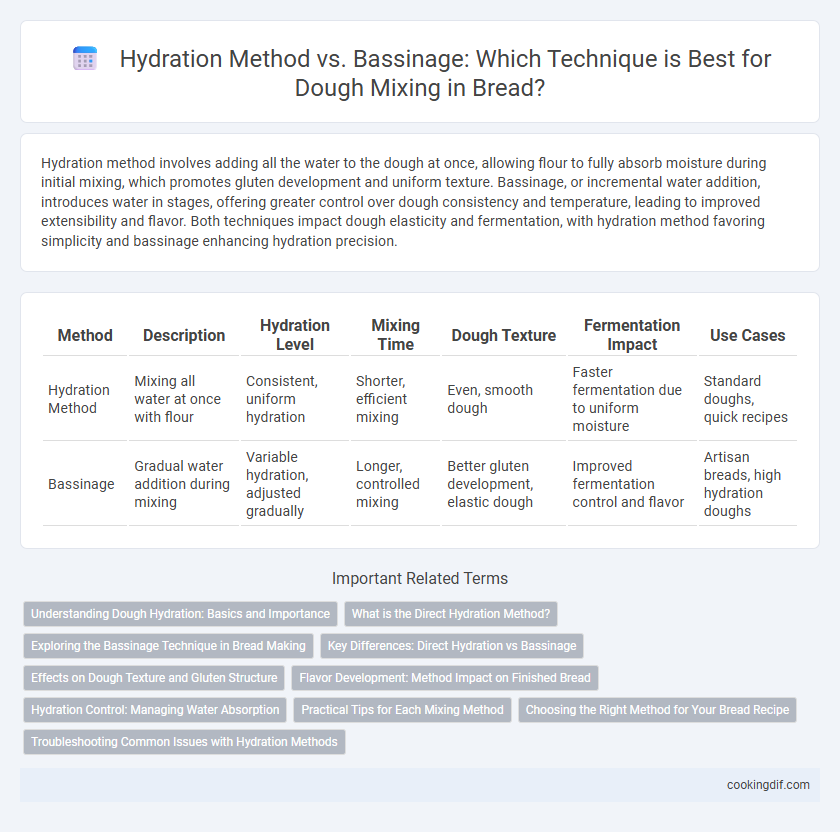Hydration method involves adding all the water to the dough at once, allowing flour to fully absorb moisture during initial mixing, which promotes gluten development and uniform texture. Bassinage, or incremental water addition, introduces water in stages, offering greater control over dough consistency and temperature, leading to improved extensibility and flavor. Both techniques impact dough elasticity and fermentation, with hydration method favoring simplicity and bassinage enhancing hydration precision.
Table of Comparison
| Method | Description | Hydration Level | Mixing Time | Dough Texture | Fermentation Impact | Use Cases |
|---|---|---|---|---|---|---|
| Hydration Method | Mixing all water at once with flour | Consistent, uniform hydration | Shorter, efficient mixing | Even, smooth dough | Faster fermentation due to uniform moisture | Standard doughs, quick recipes |
| Bassinage | Gradual water addition during mixing | Variable hydration, adjusted gradually | Longer, controlled mixing | Better gluten development, elastic dough | Improved fermentation control and flavor | Artisan breads, high hydration doughs |
Understanding Dough Hydration: Basics and Importance
Dough hydration significantly impacts bread texture, crumb structure, and fermentation efficiency, with typical hydration levels ranging from 60% to 75% depending on the recipe and flour type. The hydration method involves mixing all water at once, promoting uniform gluten development, while bassinage introduces water gradually during mixing, enhancing dough extensibility and gas retention. Understanding these methods allows bakers to optimize dough handling, improve crumb softness, and achieve consistent baking results.
What is the Direct Hydration Method?
The Direct Hydration Method involves mixing all the water directly with flour and other ingredients at once to create a consistent dough texture. This approach enhances gluten development by ensuring even hydration and reducing mixing time compared to staged addition techniques like bassinage. Bakers often prefer this method for simpler recipes and when aiming for a predictable fermentation process.
Exploring the Bassinage Technique in Bread Making
The bassinage technique in bread making involves gradually incorporating additional water into the dough after initial mixing, enhancing gluten development and dough extensibility. This method contrasts with the hydration method, where all water is added at once, potentially leading to less control over dough consistency. Bakers using bassinage achieve improved dough strength and better fermentation control, resulting in a more open crumb and superior crust in artisan breads.
Key Differences: Direct Hydration vs Bassinage
Direct hydration involves mixing all the water with flour simultaneously, promoting consistent gluten development and a uniform dough texture, crucial for artisan breads. Bassinage introduces water gradually during mixing, allowing better control over dough consistency and fermentation, often resulting in improved flavor and crumb structure. The key difference lies in the timing and method of water incorporation, impacting dough hydration management and final bread quality.
Effects on Dough Texture and Gluten Structure
Hydration method enhances dough texture by evenly distributing water, promoting consistent gluten development and resulting in a tender crumb with excellent elasticity. Bassinage involves gradual water addition during mixing, which improves gluten strength and dough extensibility, creating a more open crumb structure with greater volume. Both techniques optimize gluten network formation but differ in timing and water integration, directly influencing dough handling properties and final bread quality.
Flavor Development: Method Impact on Finished Bread
Hydration method in dough mixing significantly enhances flavor development by allowing enzymes to better break down starches and proteins, resulting in deeper, complex taste profiles in the finished bread. Bassinage, involving gradual water addition during mixing, promotes extended fermentation and improved gluten structure, which intensifies aromatic compounds and mouthfeel. Both techniques influence Maillard reactions and organic acid production, crucial for achieving rich, nuanced flavors in artisanal bread.
Hydration Control: Managing Water Absorption
Hydration method offers precise control over water absorption by gradually incorporating water into flour, allowing for optimal gluten development and dough consistency. This technique helps bakers adjust hydration levels dynamically based on flour type and environmental factors, ensuring a balanced dough structure. In contrast, bassinage involves adding water later in the mixing process, which can be less predictable for managing hydration but improves dough extensibility.
Practical Tips for Each Mixing Method
Hydration method involves gradually adding water to flour until the dough reaches the desired consistency, promoting even gluten development and easier control over dough texture. Bassinage technique requires adding water in stages during mixing, enhancing dough extensibility and allowing better absorption of liquid for improved crumb structure. For best results, use hydration method in recipes that demand precise hydration levels and apply bassinage when working with high hydration doughs to optimize dough strength and fermentation.
Choosing the Right Method for Your Bread Recipe
Choosing between hydration and bassinage depends on your bread recipe's desired crumb texture and fermentation time. Hydration involves mixing all the water with flour initially, promoting gluten development and quicker fermentation, ideal for open-crumb artisan loaves. Bassinage, a French technique, adds water gradually during mixing to enhance dough extensibility and control fermentation, perfect for enriched or high-hydration breads requiring longer fermentation.
Troubleshooting Common Issues with Hydration Methods
Hydration methods involve adding water directly to flour to achieve optimal dough consistency, but common issues include overly sticky or dry dough due to inaccurate water measurement or flour absorption variability. Troubleshooting requires adjusting hydration levels incrementally and monitoring dough texture closely to maintain gluten development and structure. Bassinage technique, which adds water gradually during mixing, can help alleviate hydration problems by allowing more precise control over dough consistency and fermentation activity.
Hydration method vs bassinage for dough mixing Infographic

 cookingdif.com
cookingdif.com